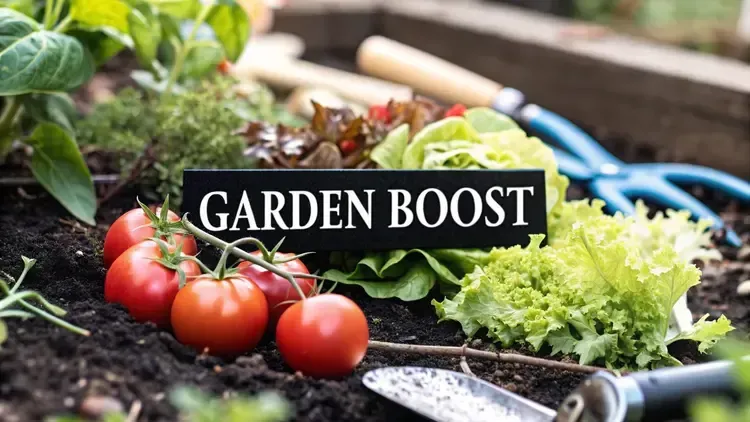
Natural Fertilizer for Vegetables to Boost Your Garden
Natural Fertilizer for Vegetables to Boost Your Garden
A good natural fertilizer for your vegetable garden does more than just pump up your plants. It builds healthy, living soil. Things like compost, aged manure, or kelp meal don’t just offer a quick meal—they feed the soil itself, creating a thriving underground world that supports your garden for the long haul. The result? Stronger plants and a much better harvest.
Why Natural Fertilizers Create Healthier Gardens
Forget the quick chemical fixes that give your plants a temporary, sugar-like rush. Choosing a natural fertilizer is like giving your garden a wholesome, balanced diet. While synthetic fertilizers blast plants with a direct hit of chemicals, natural options work from the ground up, building a robust, living soil ecosystem.
This "feed the soil, not just the plant" philosophy is really the heart of smart, sustainable gardening. Natural fertilizers—which come from plant, animal, or mineral sources—break down and release their nutrients slowly. This gentle, steady approach prevents the chemical burn that can scorch delicate roots and stress out your vegetables.
Building a Thriving Soil Ecosystem
When you add things like compost or worm castings to your garden, you're doing much more than just adding nutrients. You're introducing a whole army of beneficial microbes, bacteria, and fungi to the soil.
This microscopic life is the true engine of a healthy garden. These tiny organisms are the ones that break down organic matter, unlocking nutrients and making them easy for plant roots to absorb. They also improve the soil's structure, creating little air pockets that help roots breathe and water sink in deep.
This living soil brings some huge wins for your vegetable garden:
Improved Water Retention: Healthy, organic-rich soil acts like a sponge. It holds onto moisture much longer, which means you won't have to water nearly as often.
Better Soil Aeration: The network created by all that microbial life and organic matter keeps the soil from getting hard and compacted. This allows roots to stretch out and get the oxygen they need.
Enhanced Nutrient Availability: A bustling soil ecosystem unlocks nutrients that might otherwise be trapped in the soil, giving your plants access to a much wider menu of minerals for stronger growth.
A Healthier Garden and a Healthier Planet
This isn't just a gardening trend; it's a huge shift happening in agriculture all over the world. As more people realize the downsides of relying on chemicals, the global demand for organic fertilizers is skyrocketing. In fact, projections show the market could be worth nearly $16.97 billion by 2035. That's a pretty clear sign that we're moving toward more sustainable ways of growing. You can read more about this industry-wide shift in the full market report.
By choosing natural methods, you're becoming part of this positive movement. Your garden turns into a small-scale model of regenerative agriculture, producing healthier food while actually improving the ground it grows on. This kind of long-term thinking is a cornerstone of smart gardening. To learn how to build a productive garden from the ground up, be sure to check out our guide on garden planning for beginners.
Understanding Your Garden's Nutrient Needs
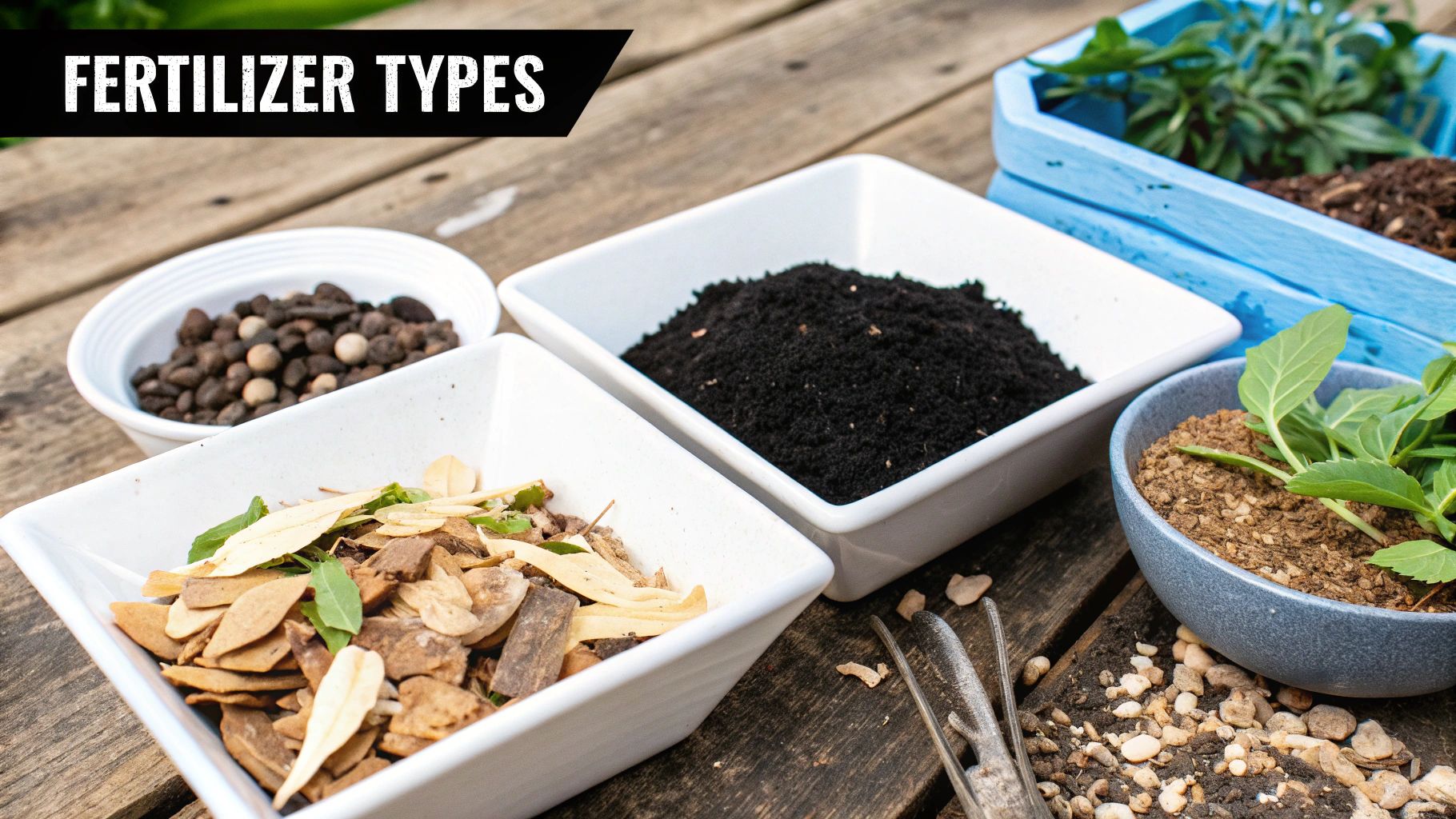
Before you can get the most out of any fertilizer, you first need to understand what your vegetables are truly hungry for. Think of your garden soil like a kitchen pantry for your plants. Just like we need a mix of proteins, carbs, and fats to thrive, your vegetables need a balanced diet of specific nutrients to grow strong and productive.
At the heart of this plant pantry are the "big three" macronutrients. You've probably seen them on fertilizer bags as the N-P-K ratio. Each one plays a distinct and critical role, and knowing what they do is the first step to a healthier garden.
The Big Three Macronutrients
The N-P-K trio works as a team, and if one is missing, the others can't do their jobs properly. Once you learn their individual roles, you'll be able to spot problems in your garden and choose the right fertilizer to fix them.
Nitrogen (N) The Leaf Maker: Nitrogen is all about vigorous, green growth. It's the main ingredient in chlorophyll, which plants use to turn sunlight into energy. A plant with plenty of nitrogen has lush, dark green leaves. This is especially vital for leafy greens like lettuce, spinach, and kale.
Phosphorus (P) The Root and Fruit Builder: Phosphorus puts its energy into building a strong foundation and setting the stage for a harvest. It fuels powerful root development, helping plants anchor themselves and absorb water. It’s also essential for flowering and fruiting, making it a key player for producing bountiful tomatoes, peppers, and squash.
Potassium (K) The Plant Protector: Think of potassium as your plant's internal security guard. It helps regulate water, strengthens cell walls, and makes plants tough enough to handle stress from drought, disease, and pests. It improves the overall sturdiness and quality of the entire plant.
The real magic of a natural fertilizer is how it delivers these nutrients. Instead of a sudden chemical flood, organic matter releases N, P, and K slowly over time. This provides a gentle, steady stream of food that your plants can use exactly when they need it.
Beyond the Basics: Micronutrients and Soil Life
While N-P-K gets most of the attention, your vegetables also need a whole cocktail of micronutrients—trace elements like calcium, magnesium, iron, and zinc. They’re like vitamins for your plants; they're needed in tiny amounts but are absolutely critical for healthy growth.
A garden with poor, lifeless soil can be low in these essential extras. This is where using a high-quality natural fertilizer for vegetables truly shines. Organic materials like compost and aged manure are packed not just with N-P-K, but with these vital micronutrients, too.
Even better, they feed the soil’s microbial life—the bacteria and fungi that break down minerals and make them available for your plants to absorb. This creates a complete and self-sustaining nutritional cycle. Building this foundation is the most important step, and you can learn more by exploring the best soil for growing vegetables in our detailed guide. A healthy soil structure ensures your plants get everything they need for a fantastic harvest.
How to Choose the Right Commercial Natural Fertilizers
While crafting your own garden gold is incredibly rewarding, sometimes life just calls for convenience. The good news is that the market for commercial natural fertilizers has exploded, offering some powerful, easy-to-use options for any vegetable garden.
Walking down the garden center aisle can feel a bit overwhelming, but you'll feel like a pro once you know what to look for.
Common choices you'll see are nutrient-rich animal products like bone meal (packed with phosphorus for strong roots and fruit) and blood meal (a big nitrogen boost for leafy greens). You'll also find fish emulsion, which is a fantastic balanced, fast-acting liquid feed that plants soak right up.
On the plant-based side, things like kelp meal and alfalfa meal are champions at providing a wide spectrum of micronutrients and natural growth hormones that improve overall plant vigor.
Reading the Label and Matching to Your Garden
When you pick up a bag, the first thing to look for is the N-P-K ratio. This trio of numbers tells you the percentage of Nitrogen, Phosphorus, and Kalium (Potassium) it contains.
A fertilizer labeled 4-6-3, for example, is great for tomatoes and peppers because it has a higher middle number (Phosphorus) to encourage blossoms and fruit development.
Think of the N-P-K ratio as a recipe. You wouldn't use a cake recipe to bake bread. In the same way, you'll want to match the fertilizer's nutrient profile to the vegetables you're growing—more Nitrogen (N) for lettuce, more Phosphorus (P) for tomatoes, and balanced Potassium (K) for overall plant health.
Next, glance at the ingredient list. Look for terms like "composted," "aged," or "slow-release." These are good signs, indicating that the nutrients will be delivered gently over time, feeding the soil ecosystem as well as your plants.
A Guide to Commercial Natural Fertilizers
With so many bags on the shelf, it helps to have a quick reference. Here’s a simple breakdown of the most common commercial natural fertilizers to help you find the perfect match for your vegetable garden's needs.

Choosing the right product isn't about finding one "best" fertilizer, but about understanding what your specific plants crave at each stage of their growth. A little nitrogen from blood meal can kickstart your lettuce, while a dose of bone meal can give your tomatoes the phosphorus they need to set fruit.
The Rise of Bio-Organic Fertilizers
A particularly exciting development in the gardening world is the growth of bio-organic fertilizers. These products are a game-changer because they combine traditional natural fertilizer ingredients with beneficial living microorganisms.
This means you’re not just feeding your plants; you're actively inoculating your soil with the helpful bacteria and fungi needed for a thriving underground ecosystem. It's a two-for-one punch.
This corner of the market is expanding like crazy, which shows a clear shift toward smarter, more holistic gardening. The global bio-organic fertilizer market was valued at about USD 3.15 billion in 2025 and is expected to grow to nearly USD 6.7 billion by 2030. That impressive growth really underscores the value these products bring. You can explore more data on this trend in the full market analysis.
When you choose a bio-organic fertilizer, you're getting a powerful advantage, feeding your plants and building superior soil health at the exact same time.
Creating Powerful DIY Fertilizers at Home
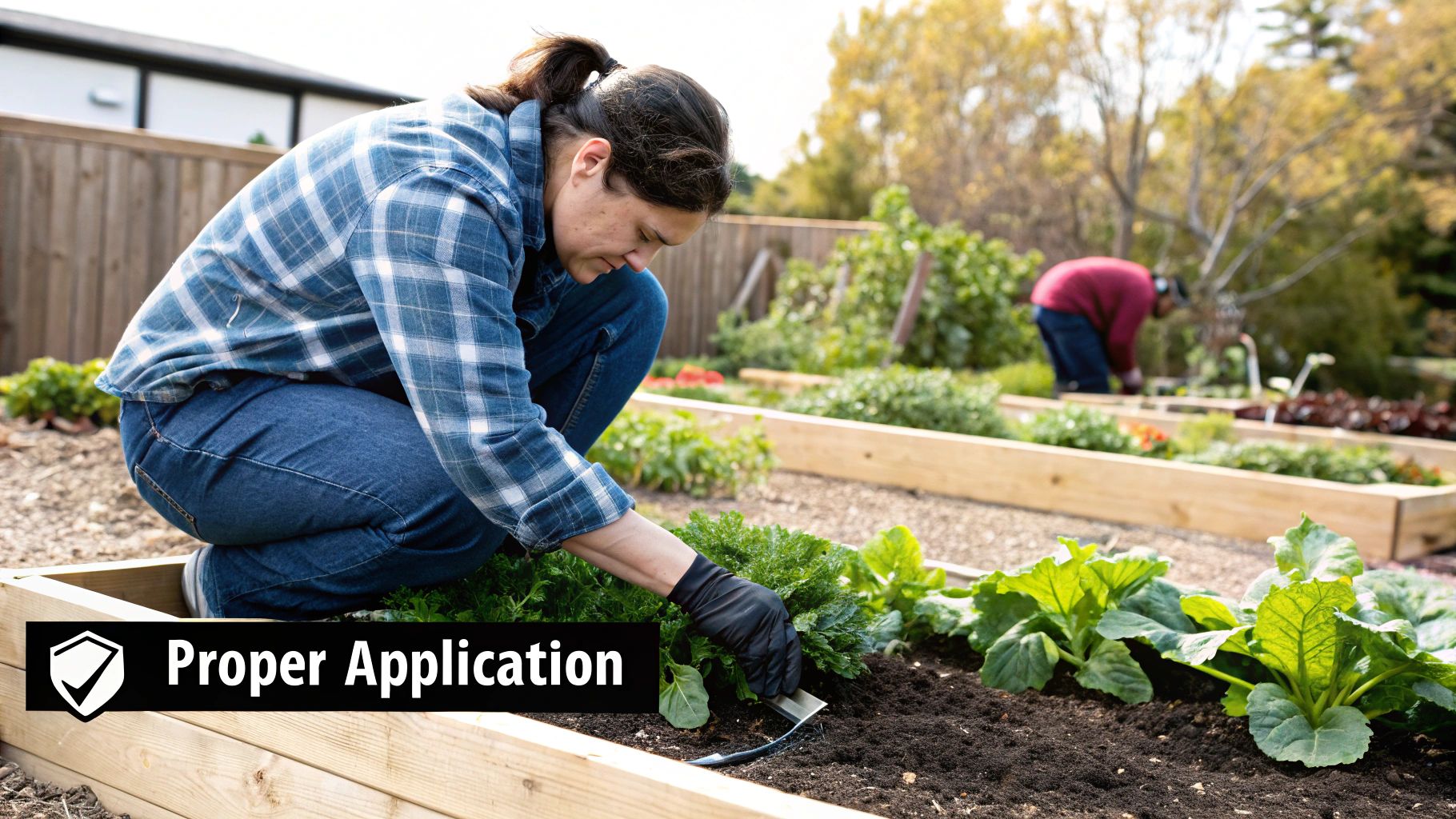
There's something deeply satisfying about turning kitchen scraps and yard waste into rich, life-giving food for your garden. It’s one of the best things you can do for your soil and your plants—and it’s a whole lot easier than you might think. This is about closing the loop, right in your own backyard.
Forget the simple compost pile for a minute. We're going to dig into a few powerful, homemade methods that will not only feed your vegetables but also cut down on waste and save you money. These are the tricks that take your soil from good to truly exceptional.
Brewing Nutrient-Rich Compost Tea
Think of compost tea as a probiotic energy drink for your garden. It's a living, liquid fertilizer that gives your plants a quick shot of nutrients. More importantly, it drenches the soil with a massive army of beneficial microbes that get to work right away.
Brewing a batch is surprisingly simple. You just need a bucket, a basic aquarium pump for air, a mesh bag (an old paint strainer works great), and a scoop of your best finished compost.
Simple Compost Tea Recipe:
Fill a 5-gallon bucket with water that's free of chlorine. If you're using tap water, just let it sit out for 24 hours for the chlorine to dissipate.
Scoop 2-3 cups of high-quality, finished compost into your mesh bag and tie it shut.
Drop the "tea bag" into the bucket and submerge the aquarium pump’s airstone to keep things bubbling.
For an extra kick, stir in one tablespoon of unsulfured molasses. This is pure food for the microbes, helping them multiply like crazy.
Let it brew and bubble for 24 to 36 hours. When it's done, it should smell rich and earthy, not sour.
Use the tea right away. Dilute it with water—a 1:4 ratio of tea to water is a good starting point—and use it to drench the soil around your plants or as a foliar spray. It’s the perfect pick-me-up for plants that need a boost during the peak of the growing season.
The Magic of Vermicompost Black Gold
If finished compost is garden gold, then vermicompost is pure black gold. This stuff, also known as worm castings, comes from a worm farm and is hands-down one of the most nutrient-packed organic fertilizers you can get. Worms digest organic matter and turn it into perfectly broken-down castings that are brimming with life.
Worm castings are a powerhouse. Their nutrients are water-soluble, meaning your plants can slurp them up instantly. They also do wonders for your soil’s structure, help it hold onto moisture, and introduce enzymes and good bacteria that protect your plants from disease.
Setting up a worm bin is a fantastic weekend project. You just need a shallow bin with a few drainage holes, some moist bedding like shredded newspaper, and a starter population of red wiggler worms. Add your kitchen scraps (just steer clear of meat, dairy, or oily foods), and the worms do the rest, transforming your garbage into a priceless natural fertilizer for vegetables.
Putting Common Kitchen Scraps to Work
Even if you don't have a full compost system, your kitchen is already producing some great garden amendments. Don't let them go to waste.
Coffee Grounds: Your morning coffee grounds offer a gentle nitrogen boost. They're slightly acidic, which makes them a great match for acid-loving plants like tomatoes and peppers. It’s best to add them to a compost pile, but you can also sprinkle them sparingly around your plants and gently work them into the top layer of soil.
Eggshells: Don't toss those eggshells. Rinse them, let them dry, and crush them into a fine powder. This creates a fantastic source of calcium, which is crucial for preventing blossom-end rot on tomatoes and squash. The key is to grind them as finely as you can—the smaller the particles, the faster the calcium becomes available for your plants to use.
By using these DIY methods, you’re not just feeding your garden; you’re taking full control over what goes into your soil, making sure your vegetables get pure, homemade goodness from start to finish.
Applying Natural Fertilizers for Maximum Growth
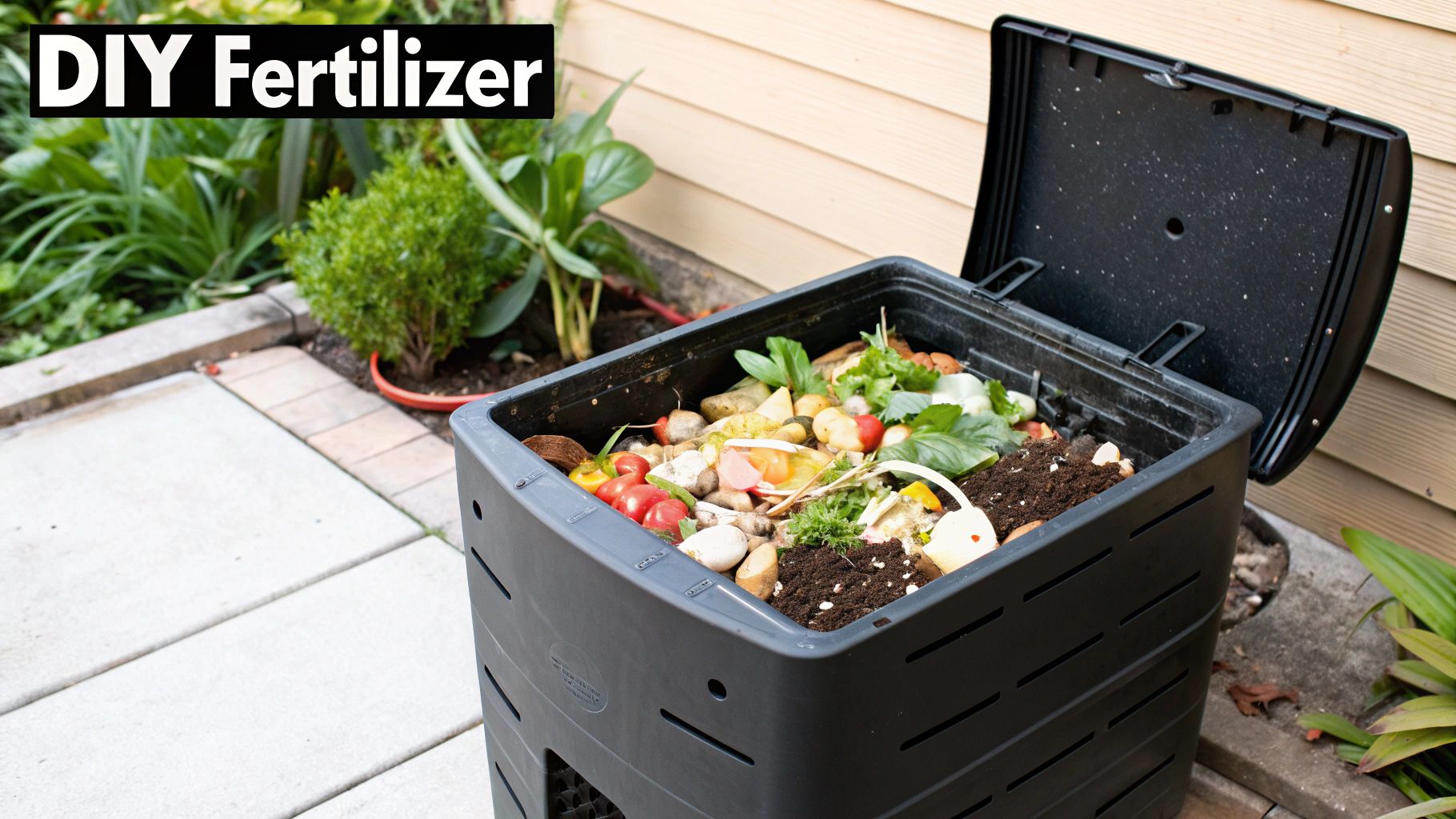
Having the perfect natural fertilizer is only half the battle. Knowing how and when to apply it is what separates a decent garden from one that delivers an explosive, bountiful harvest. Think of it like a perfectly timed meal—you have to give your vegetables the right nutrients at the right time to see them truly thrive.
The way you feed your garden depends on the fertilizer you’re using and where your plants are in their life cycle. Let's walk through the three main techniques every gardener should have in their back pocket.
Core Application Techniques
1. Incorporating Amendments
This is your foundation, the work you do before a single seed goes in the ground. When preparing a new bed, you’ll want to work solid, slow-release fertilizers like compost or well-aged manure directly into the top 4-6 inches of soil. This builds a nutrient-rich base that will steadily feed your plants for months.
2. Top Dressing
This is the "set it and forget it" method for established plants. You simply spread a thin layer of granular fertilizer or compost on the soil surface around the base of your plants. Every time you water, nutrients are slowly carried down to the roots. It’s like a slow-and-steady meal that keeps them going.
3. Side Dressing
Think of this as a targeted power-up for your hungriest plants, especially mid-season. You create a shallow trench a few inches from the plant's base, sprinkle in your granular fertilizer, and cover it back up with soil. This delivers an extra shot of fuel right to the root zone, exactly where it’s needed most.
Remember this critical rule: Always water your plants thoroughly after applying any type of natural fertilizer. Water is the vehicle. It's what carries those nutrients from the soil down to the roots, making them available for your plants to use. Without it, your fertilizer is just sitting on the surface, doing nothing.
A Simple Feeding Schedule
Not all vegetables have the same appetite. Some are incredibly hungry, while others are light snackers. Matching your feeding schedule to their needs prevents waste and gives you much better results.
Here’s a basic guide to get you started:
Heavy Feeders (Tomatoes, Corn, Squash, Peppers): These plants are ravenous. They need a strong start and regular boosts. Work compost into the soil at planting, then side dress with a balanced natural fertilizer for vegetables right as they start to flower or set fruit. For a detailed game plan, check out our organic tomato feeding guide.
Light Feeders (Lettuce, Spinach, Radishes, Beans): These veggies are far less demanding. A good dose of compost incorporated into the soil before you plant is usually all they need to get through their entire (and much shorter) life cycle.
This shift toward organic methods isn't just happening in backyards; it's a global movement. The organic vegetable farming market was valued at around USD 9.04 billion in 2024 and is growing steadily. This boom is tied directly to the use of natural fertilizers, which are the cornerstone of producing healthy, certified organic food. You can explore more on this market trend and its drivers.
Got Questions About Natural Fertilizers? You're Not Alone.
Jumping into the world of natural fertilizers can bring up a lot of questions. It's a whole different way of thinking about your garden—you're moving away from quick chemical fixes and toward building rich, living soil for the long haul. Let's clear up some of the most common points of confusion so you can get growing with confidence.
These are the questions we hear all the time from gardeners making the switch. Getting straight, simple answers can make all the difference.
How Often Should I Use Natural Fertilizer on My Vegetables?
This is easily the most common question, and the honest-to-goodness answer is: it depends. How often you apply fertilizer hinges on the type you're using and, more importantly, what your vegetables need at their current stage of growth.
Slow-release, solid fertilizers like compost or aged manure are usually worked into the soil just once at the beginning of the season. For heavy feeders like tomatoes or corn, you might want to give them a second helping, or "side dress," right when they start setting fruit. That mid-season boost can make a huge difference.
On the other hand, fast-acting liquid fertilizers like compost tea or fish emulsion are like a quick energy snack for your plants. They're best applied every two to four weeks during the peak of the growing season to give your veggies an immediate lift.
The single best piece of advice is to just watch your plants. They’ll show you what they need, whether it’s yellowing leaves (a classic cry for nitrogen) or just sluggish growth. When in doubt, it’s always safer to apply too little natural fertilizer than too much.
Can I Put Fresh Manure Directly in My Garden?
Let's make this one simple: an absolute, unequivocal no. Never, ever add fresh manure directly to your vegetable garden.
Fresh manure is considered "hot" because it's incredibly high in raw nitrogen and ammonia. It will scorch the delicate roots of your plants and, in most cases, kill them outright.
Beyond the risk of burning your plants, fresh manure can also carry harmful pathogens like E. coli that you definitely don't want anywhere near your food. This is why properly aging or composting manure isn't just a friendly suggestion—it's a critical safety step.
Manure has to be either fully composted or left to age for at least six months to a year. This process does two vital things:
It allows the intense nutrients to mellow out, transforming them into a stable, slow-release form that won’t harm your plants.
The heat from composting and the time spent aging effectively kills off dangerous pathogens, making it completely safe for your garden.
Are Coffee Grounds a Good All-Purpose Fertilizer?
Coffee grounds are a fantastic addition to your garden, but they aren't a complete, all-purpose fertilizer on their own. Think of them more like a great supplement, not the main course.
They offer a nice, gentle boost of nitrogen and are slightly acidic, which makes them a welcome treat for acid-loving vegetables like tomatoes and peppers.
The catch? They're missing the other two macronutrients your plants crave: phosphorus and potassium. The very best way to use coffee grounds is to toss them into your compost pile. There, they'll balance out with other materials and add to a rich, well-rounded finished product.
If you want to apply them directly, just do it sparingly. Sprinkle a thin layer on the surface and gently work it into the top inch of soil. This keeps the fine grounds from clumping together and forming a water-repellent crust.
What's the Difference Between a Fertilizer and a Soil Amendment?
This is a fantastic question that gets right to the heart of what makes natural gardening so powerful. The terms are often used interchangeably, but they have very different primary jobs.
A fertilizer is designed to feed the plant. Its main goal is to deliver specific nutrients—like Nitrogen (N), Phosphorus (P), and Potassium (K)—directly to the plant to fuel its growth.
A soil amendment, on the other hand, is designed to feed the soil. Its main goal is to improve the soil's physical properties—its structure, its ability to hold water, and its aeration.
Here's the beautiful part: a great natural fertilizer for vegetables, like compost or worm castings, does both jobs at once. It’s a powerful soil amendment that adds organic matter, improves structure, and feeds the microbial life in your soil. At the same time, it serves as a slow-release fertilizer, providing a full spectrum of nutrients for your plants. This dual-action benefit is what builds a truly healthy and productive garden from the ground up.
At The Grounded Homestead, we believe that growing your own food is one of the most rewarding steps you can take toward a healthier life. We're here to provide the knowledge you need to turn that interest into a thriving garden. Explore our resources and join our community at https://thegroundedhomestead.com.

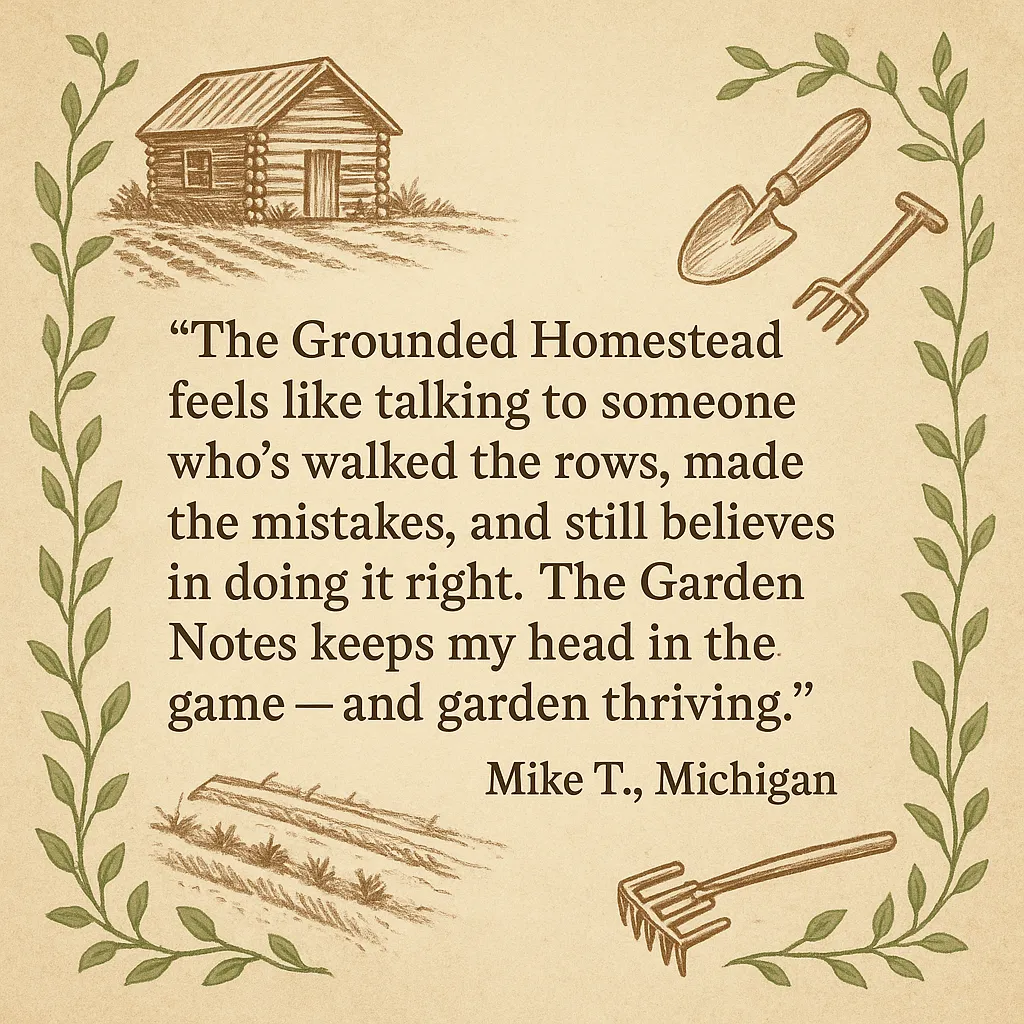
Facebook
Instagram
X
Youtube